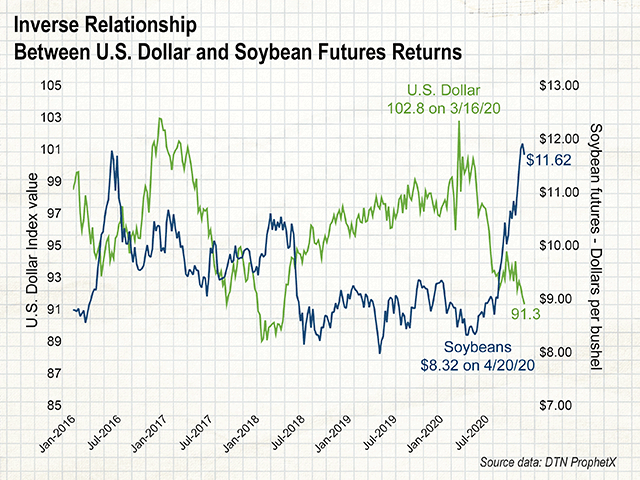Kub's Den
Grains and the Dollar: An Imperfect but Negative Relationship
Life is full of eerie little coincidences: You dream of a long-forgotten friend one night, then they call you the next day -- or you just happen to notice your 10 millimeter wrench laying on the wrong workbench the day before it's urgently needed for a repair. I have friends who would argue these aren't just coincidences; there are deeper, more meaningful forces at work.
I'm not sure I believe them about the phone calls and the lost-and-found treasures, but when it comes to opposite movement in the U.S. dollar and the grain markets, I do agree there are deeper forces at work.
The U.S. Dollar Index, a unitless representation of what a basket of other foreign currencies are worth from moment to moment, has -- during the course of the pandemic -- fallen 11% from its mid-March high of 102.8. During that same timeframe, Chicago soft red winter (SRW) wheat futures prices have risen 6%, corn futures prices have rallied 20%, and most impressively, soybean futures have rallied 30% with virtually no interruptions.
This is more than a coincidence.
The typically-attributed reasons for the row crops' rally are well known to DTN readers: weather troubles in major Northern Hemisphere growing regions (derecho and drought in the U.S. Corn Belt, wet harvest damage in China) and a surge of American export sales of soybeans and corn to China and Mexico, among others, while the South American supply pipeline has effectively run dry. The lower-trending dollar has been an additional bullish influence in the background.
P[L1] D[0x0] M[300x250] OOP[F] ADUNIT[] T[]
What are the reasons for the dollar's own movement? First, consider how quickly the dollar streaked higher in early March when the risks of a global pandemic -- the population losses and the business losses -- became clear to investors. The U.S. dollar is considered a "safe haven" asset in times of uncertainty and financial risk. Because it is always backed by the full faith and credit of the world's largest, most well-run democratic country, global investors know they can always just park their wealth by holding U.S. dollars, and even if they won't earn huge returns, they likely won't lose value. The mid-March high in the dollar's value occurred when everybody was freaked out and the dollar looked like one of the only safe assets to own.
But since then, the U.S. Federal Reserve has reassured the markets of its intention to maintain extremely loose monetary policy (low interest rates and quantitative easing) not only during the worst of the pandemic, but even after the economy begins to recover. Investors no longer needed to cower in safe-haven assets; they were encouraged to pull their money out of dollars and put it into stocks, commodities or whatever riskier assets they felt would earn them better returns.
More recently, the lower dollar has been pressured even further by two developments:
-- Janet Yellen being picked to be the next Treasury Secretary, assuring the markets of extremely accommodative decision makers guiding both monetary policy (ultra-low interest rates) and fiscal policy (budget deficits).
-- The hope of widespread vaccination that could effectively end the pandemic and all of its human and economic losses sometime in 2021. A real economic recovery across the globe would mean more consumption of commodities like oil and steel and, yes, grains.
Countries with currencies that rely on exporting commodities, such as Brazil, benefit from an outlook for eager consumption in 2021. For instance, the Brazilian real has popped up 2% in the month of November with all the vaccine-related optimism. And, since the U.S. Dollar Index is measured relative to other currencies, it necessarily moves lower while foreign currencies move higher.
If, on any given day, absolutely nothing else changed for the grain markets (there was no adjustment to the weather outlook for South American production, no doubt about demand and no other fundamental piece of news) and the only thing that shifted in the outside markets was the price of the U.S. dollar, then dollar-denominated grain prices would always predictably move in an opposite direction to the dollar. A cheaper dollar (and thus more purchasing strength for foreign currencies) would allow foreign buyers to pay a relatively higher dollar price tag for each bushel of grain.
The day-to-day relationship, in reality, isn't as pure and predictable as that. But it's no coincidence that periods of low value for the U.S. dollar often occur at the same time as periods of high prices for U.S. grains and vice versa.
Therefore, for people who want to get a sense of where grain prices might go from here, it may be useful to consider what trajectory the U.S. Dollar Index might take going forward. There are some traders who believe all the dollar bearishness is already priced in and only bullish surprises can occur from here on out. Most prognosticators are confident enough in the Fed's (and the government's) abundant support for a cheap dollar and well-lubricated asset markets that they expect the dollar could continue falling anywhere from 3% to 20% through the next year. This wouldn't directly equate to an additional 3% or 20% rally in grain futures prices, but nevertheless, if we share this confidence in a "lower for longer" dollar, then at least we have one less threat to pull grain prices back to their old ranges.
Elaine Kub is the author of "Mastering the Grain Markets: How Profits Are Really Made" and can be reached at masteringthegrainmarkets@gmail.com or on Twitter @elainekub.
(c) Copyright 2020 DTN, LLC. All rights reserved.




